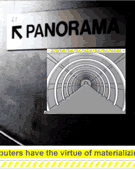The desire for a totalizing view of our environment is overwhelming, and is reflected in the technological evolution of maps, diagrams, biological imaging, and databases. But, according to (writer, anthropologist and curator) Bruno Latour's web-based work 'Paris: Invisible City', such attempts at exhaustive cartographic indexes only hinder vision. Paris, for Latour, is not tracked by static, isolated images, but rather by the traces of the transitory and interdependent. The city is visualized through the social and technical networks that give meaning to spaces, like the tourist map that depends on an infrastructure of manufactured and maintained architectural signage. 'Invisible City' combines ethnographic observations, theoretical discourse and photographs (by Emilie Hermant) in the form of a 'sociological web opera' with four acts and fifty-three 'plans'. The Flash interface (designed by Patricia Reed) discourages the singular perspective that Latour critiques, allowing for a non-linear process of discovery. And although the text makes more sense when read sequentially, the disparity is interesting. This experience of tension between controlled and open movement is a lot like that of moving through physical cities. - Ryan Griffis


